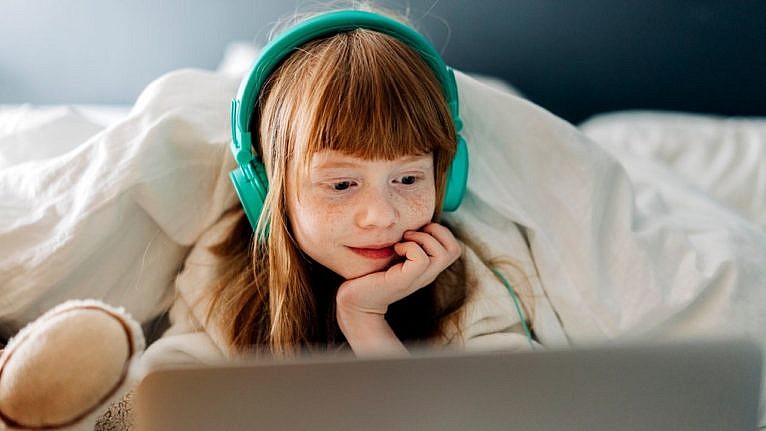Here’s what you need to know about protecting your kid’s hearing when they’re using headphones.

Photo: iStock/HRAUN
Between online schooling, downtime gaming and binge watching Netflix, many kids have spent much of the past year with an added artificial appendage: headphones or buds plastered to their ears. Which makes many parents wonder if headphones can cause permanent hearing damage. The answer is, yes and no.
“Headphones are not specifically more dangerous compared to other sources of noise. However, they can be a vehicle for dangerous noise exposure if used incorrectly,” says Boris Chang, an audiologist with Hearing Life in Scarborough, Ont.
Susan Scollie, director of the National Centre for Audiology at Western University and professor at Western University in the Faculty of Health Sciences, explains it this way: “The danger is listening to something really loud for a long time. You need to limit the volume and duration.” Noise-induced hearing loss is cumulative. If your kid is frequently exposed to loud noises for long durations they risk doing permanent damage.
What the research says about kids’ headphones
Most of the data on long-term hearing loss is from studies on adults’ workplace exposure to noise. Eight hours of exposure to sounds at 85 decibels (dB), which is equivalent to the noise in a crowded restaurant or heavy traffic, is considered harmful. So if your kid is listening to movies, music or video games at 85 dB or higher for that length of time at once or cumulatively throughout the day, they could be at risk.
Volume is the key factor. Sound levels of 70 dB (equal to the hum you hear driving in a car at highway speeds) or lower can be listened to for any length of time without any risk. Sounds above 100 dB can cause permanent damage within minutes; above 125 dB (what you’d hear at a loud concert or trackside at a car race without ear protection) and the damage starts within seconds and could be irreparable.
Children under 5 years of age have shorter ear canals than older kids and adults, which amplifies sound. As Chang explains, it’s generally understood in acoustics that the smaller an enclosed space, the larger the volume. Audiologists will regularly compensate for ear canal volume differences when fitting hearing aids, he says. The same concept can theoretically be applied to headphone use and volume. This is all to say that extra vigilance should be placed on minimizing exposure to loud sounds with babies, toddlers and preschoolers.
Are earbuds bad for hearing?
One potential problem with earbuds (and some models of over-the-ear headphones) is that they’re designed to be “acoustically open,” meaning they allow ambient noise in. That’s a good thing if you’re, say, jogging and need to hear cars and other hazards around you. The problem is our tendency to try to block out that background sound by turning the volume up.
Again, there doesn’t seem to be any child-specific research on the issue, but a 2007 study in the journal Ear and Hearing compared the listening habits of adults using earbuds versus those using over-the-ear headphones and found that “listening levels are higher with [earbuds] compared to the over-the-ear style. Moreover, as the noise level in the environment increases, earbud users are even more susceptible to background noise and consequently increase the level of the music to overcome this.”
Another potential side effect is that earbuds, particularly those with deep-seated rubber tips, can cause impacted ear wax. “I have actually seen the shape of the earbuds in the wax,” says Chang. This is treatable but will diminish hearing until the impacted wax is removed.
What can a parent do?
Luckily, parents do have some options to help avoid hearing damage in their children, and the key is to limit the volume and the length of time kids spend using earphones.
Many devices have settings that allow you to control the maximum volume output. With an iPhone, for example, in the settings look for “Sounds & Haptics” and then the “Headphone Safety” tab. This will let you adjust the maximum volume from 100 dB down to 75 dB.
You can also buy volume-limiting headphones that cap the sound output reaching a kid’s ears, no matter how high the volume is on the device they’re using. “Those are legit, they are really good,” says Scollie, who used them with her own children when they were younger.
When travelling on a subway or airplane, or spending time in a loud space, the background noise is elevated so the tendency is to crank up the volume. “If you can hear the signal coming out of your child’s headphones or earbuds, it is too loud,” says Chang. You can look for deep-seated earbuds that have a snug fit in a child’s ear or alternatively, headphones that are “noise cancelling,” meaning they block out external sounds while being used so that users can lower the volume on their device and still hear clearly.
Children (and adults) should also give their eardrums time to rest. Chang recommends a two to one ratio, “If you’re wearing headphones for two hours, take an hour off to give your ears a bit of a break.”
Finally, some kids are more predisposed to hearing loss. If your child has already been flagged for concern, either during infant hearing screening or following a diagnosis by a paediatrician, Chang advises frequent checks up and being extra cautious with the maximum volume you allow.
FILED UNDER: health service seo Hearing Hearing loss
Source link : https://www.todaysparent.com/kids/kids-health/can-headphones-really-cause-hearing-loss-in-kids












